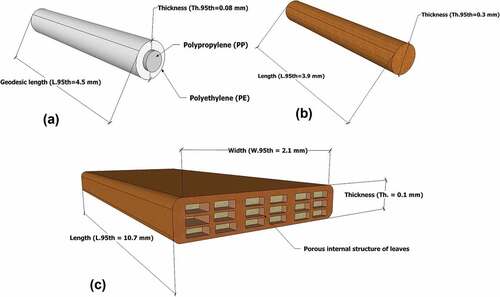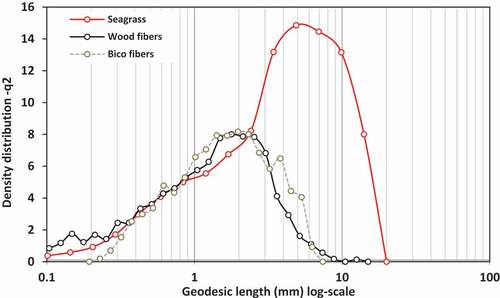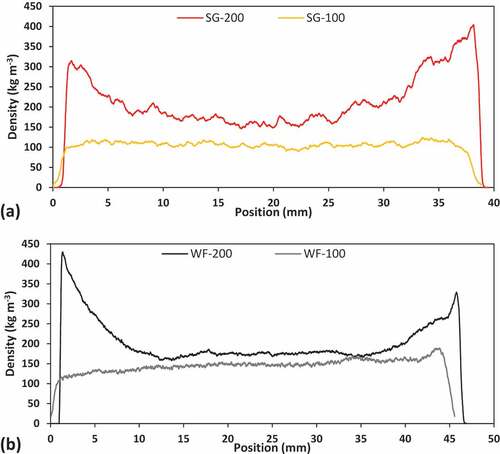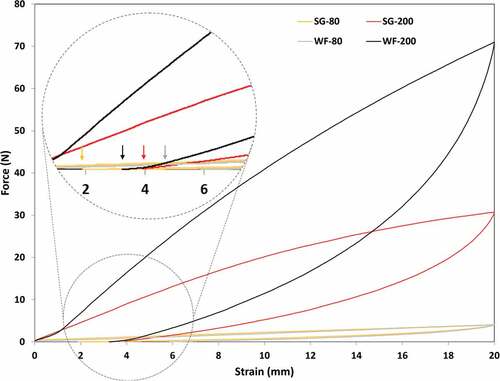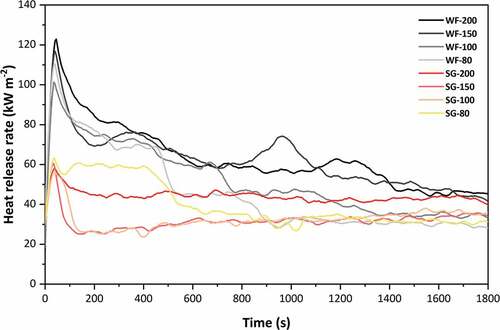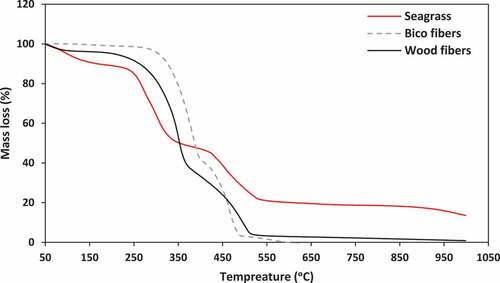ABSTRACT
The dead seagrass leaves accumulated on the seashores, also known as beach (seagrass) wracks, can be considered a sustainable and ecologically beneficial source for application in the construction sector. An innovative thermal insulation material composed of Zostera marina seagrass leaves was developed using bicomponent fibers as a binding agent. The bicomponent fibers consisted of polypropylene in the core and polyethylene in the sheath. This work aimed to investigate the effect of mat density on mechanical properties (compression and internal bond strength), thermal conductivity and fire properties. The seagrass-based (SG) mats were compared to reference mats consisting of wood fibers (WF). The digital and scanning electron microscopy investigation revealed the differences in the bonding mechanism between the two types of mats. Although slightly higher than WF mats, the thermal conductivity of SG mats still varied from 0.039 to 0.051 W m−1 K−1 and is comparable to those of other natural fiber-based boards with the same density range. The low peak heat release of SG mats (up to 63% lower than wood fiber-based mats) indicates their high resistance to fire. SG mats provide novel possibilities for using new environmentally friendly materials intended for ceiling and partition applications.
摘要
堆积在海边的死海草叶,也被称为海滩(海草)残骸,可以被认为是建筑领域应用的可持续和生态有益的来源. 使用双组分纤维作为粘合剂开发了一种由 Zostera marina 海草叶组成的创新隔热材料. 双组分纤维由芯中的聚丙烯和外皮中的聚乙烯组成. 这项工作旨在研究垫子密度对机械性能(压缩和内部结合强度)、导热性和防火性能的影响. 将基于海草的 (SG) 垫子与由木纤维 (WF) 组成的参考垫子进行了比较. 数字和扫描电子显微镜研究揭示了两种垫子之间粘合机制的差异. 虽然略高于 WF 垫,但 SG 垫的导热系数仍然在 0.039 至 0.051 Wm-1 K-1 之间变化,与具有相同密度范围的其他天然纤维基板相当. SG 垫的低峰值热释放(比木质纤维垫低 63%)表明它们具有高防火性. SG 垫子为使用用于天花板和隔断应用的新型环保材料提供了新的可能性.
GRAPHICAL ABSTRACT
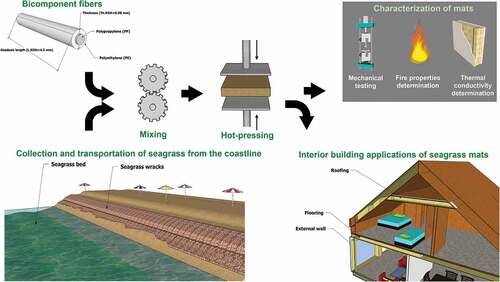
Introduction
The building sector in the EU is responsible for 40% of the energy consumption and 36% of greenhouse gas emissions, which mainly stem from construction, usage, renovation and demolition (Tsemekidi-Tzeiranaki et al. Citation2019). Nowadays, intelligent solutions and sustainable development efforts in construction are gaining high significance. One of the most effective measures for implementing green technology is the utilization of natural resources and agro-industrial wastes.
Other than natural or waste lignocellulosic resources, products derived from wood have also been trending over the last years. Wood fibers have been widely used in construction as they are considered a sustainable and eco-friendly alternative for the production of insulation materials (Imken, Kraft, and Mai Citation2021; Schulte et al. Citation2021). Apart from being environmentally friendly, wood fiberboards are excellent thermal insulators; they are breathable, soundproofing and can be installed and handled easily. However, despite their advantages, they also seem to have some drawbacks. In some cases, the raw materials might not be widely available. Their high cost is another factor that might affect their commercial application. In particular, the production of wood fibers requires a high energy input, which increases their cost (Schulte et al. Citation2021). Another common problem of organic insulation materials is their relatively low fire resistance. Most of them are classified as highly combustible and possess low resistance to fire (Graupner and Müssig Citation2010; Kumar et al. Citation2020; Zou et al. Citation2021).
Along with other resources, seagrasses have emerged as an attractive alternative solution for their application in construction. Seagrasses are aquatic flowering plants native to marine environments. As a result of the windy weather conditions, seagrass leaves break, and moved by the force of the waves are washed onto the shore creating an unpleasant view, which is a problem, especially during the tourist season. Therefore, local authorities are usually compelled to clean these shores. Although it is considered a waste product, seagrass is a functional raw material (Kuqo, Korpa, and Dhamo Citation2019). Among the various seagrasses, Posidonia oceanica (Mediterranean seagrass) is one of the most extensively studied species. Specifically, fiberboards composed of Posidonia oceanica have been regarded as adequate alternatives to other thermal insulation materials, as they display a very low thermal conductivity (Ayadi et al. Citation2022; Hamdaoui et al. Citation2018; Kuqo and Mai Citation2022; Zannen et al. Citation2022). In other cases, incorporating seagrass fibers and leaves into mineral matrixes (gypsum, cement) has led to the improvement of thermal insulation (Jedidi and Abroug Citation2020; Mehrez et al. Citation2022). However, only a few studies deal with the investigation of Zostera marina seagrass species to be used for building insulation. Zostera marina leaves have been considered an effective insulation material since the 20th Century due to the high demand for energy-saving products (Wyllie-Echeverria and Alan Cox Citation1999). Cabot’s Quilt has been a popular commercial building material from the 1900s to the 1940s. The “blanket type” seagrass covered with the paper was advertised as a lightweight, heat- and sound-insulating, cost-effective material for loose-fill application in walls (Wyllie-Echeverria and Alan Cox Citation1999). The low energy requirements for the processing energy (typically about 10 times less than conventional materials) implies low production costs and makes seagrass an ecologically friendly building solution (Teppand, Jones, and Brischke Citation2017).
Although some of the characteristics of Zostera marina seagrass are already known from the past, no research has yet been carried out in the area of flexible insulation composites and their mechanical and physical characterization. Thus, the purpose of this paper is to fill this gap by examining the properties of flexible mats produced from the Zostera marina and comparing them with those of wood fiber mats. In addition to the mechanical and thermal properties, we studied the fire resistance and discussed the leaf/fiber size, the vertical density profile and their effect on the material’s major properties.
Experimental part
Materials
Zostera marina seagrass leaves were provided by Seegrashandel GmbH (Westerau, Germany). The raw material was collected in the Baltic Sea. The dried, brownish leaves were from 5 to 60 cm long. They were cut into shorter pieces to avoid problems in the mixing process. For the production of reference mats, we used pine wood fibers (Pinus sylvestris) provided by Steico SE (Feldkirchen, Germany). Bi-component fibers (Bico), provided by (AL-Adhesion C, FiberVisions, Varde, Denmark), were utilized as a binding agent. Bico fibers consisted of two distinct raw polymeric components (Polypropylene in the inner layer and Polyethylene in the outer layer). shows the shape and size of the raw materials and the structure of the binder.
Methods
Size distribution of raw materials and binder
The size distribution (geodesic length) of seagrass leaves, wood and Bico fibers was determined using FibreShape PRO (X-shape, IST, Vilters, Switzerland). Representative samples of processed (after passing the mixing process) seagrass leaves (2 g), wood fibers (0.15 g) and Bico fibers (0.05 g) were manually dispersed on a transparent film and scanned using a flatbed scanner (Epson Perfection V850 Pro, Epson, Tokyo, Japan) in transmitted light mode. High-resolution images were created and scans were then loaded to the FiberShape software.
Production of insulation mats
The mats were produced by mixing 90 wt% raw material and 10 wt% Bico fibers followed by hot-pressing. The raw materials and Bico fibers were initially vigorously mixed using a hammer mill (Electra SAS VS1, Poudenas, France). The mixture was pre-pressed and then hot-pressed at 190°C. The hot-pressing time was 640 s (16 s mm−1 thickness). A hot press (Joos HP-2000 lab, Gottfried Joos GmbH & Co.KG, Pfalzgrafenweiler, Germany) was utilized for the pressing operation. Two mats for each variant (in total, 16 mats) were prepared. The mats had 4 different target densities (80, 100, 150, and 200 kg m−3) and their dimensions were 450 × 450 × 40 mm3. The abbreviations of the produced boards are shown in .
Table 1. Abbreviations for seagrass-based (SG) mats and wood fiber-based (WF) mats with various densities.
Mechanical characterization
Before the determination of the physico-mechanical properties, the mats were cut into various specimen sizes and were conditioned at 50 ± 5% RH and 23 ± 2°C. Specimens whose density was within ±10% of the target density were selected for the following mechanical tests. For the compression test, a compressive force was applied perpendicular to the faces of the test specimen at a constant speed (0.1 d min−1 ±25%, in which d is the thickness of the test specimen in mm) using a universal testing machine (ZwickRoell Zmartpro, ZwickRoell, Ulm, Germany) with a 10 kN load cell. The tests were conducted according to EN 826 (Citation2013). The internal bond (tensile strength perpendicular to the faces) was evaluated following EN 1607 (Citation2013). The test specimens (with nominal dimensions of 50 × 50 × 40 mm3) were glued with a fast-curing polymer adhesive between two stiff boards and thereafter were installed in the universal testing machine. Tensile stress was applied at a constant speed of 10 mm min−1. An additional test was performed to determine the flexibility (or bendability) when a bending force is applied. Specimens were tested in a three-point bending test set up using a universal testing machine (ZwickRoell Zmartpro, Ulm, Germany), with the load applied to the specimen midway between the two supports. Specimens with dimensions of 300 × 50 × 40 mm3 were used for this test. The support span was 200 mm. The diameter of the load and support rollers was 15 mm. The specimens were bent to an elongation of 20 mm (or 0.5 d, where d is the thickness of the specimen in mm), and the applied force was recorded at a rate of 10 mm min−1. After reaching the target elongation of 20 mm, the load was reversed at the same speed (10 mm min−1) and the applied force was recorded until the loading roll reached its initial position. The flexibility of the material was expressed as elongation (mm) divided by the applied force (N).
Density profile measurements
The X-ray density profile was determined using a Grecon Density profiler (Fagus-GreCon Greten GmbH & Co., Alfeld, Germany). For the density profile measurements we selected representative specimens with target densities of 100 and 200 kg m−3 for each type of mat. Specimens with dimensions 50 × 50 × 40 mm3 were inserted into the machine so that the X-ray ran in the vertical direction. The X-ray scanning speed was 2 mm s−1.
Microscopy investigation
The cross-section part of mats’ specimens was imaged using the Keyence VHX-5000 digital 3D reflected light microscope (Keyence, Neu-Isenburg, Germany). The acquired images were captured at magnifications of 50× and 150 × .Scanning electron microscope (SEM) images were taken using a Zeiss EVO LS 15 Microscope (Carl Zeiss Microscopy GmbH, Jena, Germany). The acquired SEM images were captured at magnifications of 164× and 430× for seagrass- and wood-based mats specimens respectively.
Thermal conductivity measurements
A 446 Lambda Eco-Line Heat Flow Meter (NETZSCH Group, Selb, Germany) was utilized to determine thermal conductivity. The test procedure was in accordance with the standard EN 12667 (Citation2001). One specimen per board (in total 8 specimens for each type of mat) measuring 250 × 250 × 40 mm3 were tested at mean temperatures varying from 10 to 30 ºC. The thermal conductivity at 23 ºC (λ23) was calculated by applying linear regression.
Cone calorimetry tests and thermogravimetric analysis
The procedure described in the standard ISO 5660–1 (Citation2002) was adopted for the cone calorimetric measurements using a mass loss calorimeter (MLC FTT, Fire Testing Technology, East Grinstead, UK). Tetragonal specimens (100 × 100 mm2) with a given thickness were exposed to a heat flux of 50 kW m-2 for 30 min. The thermogravimetric analysis was performed using a NETZSCH TG 209F1 Iris (Erich NETZSCH GmbH & Co. Holding KG, Selb, Germany). The test was carried out using an oxidative environment (a mixture of 4 mL min−1 oxygen and 16 mL min−1 nitrogen) to imitate the combustion of raw materials under natural conditions. The samples were placed in open alumina crucibles. The heating rate for the test was 20 K min−1 starting from 50 to 1000 ºC.
Results and discussion
Size distribution and morphological considerations
Static image analysis revealed the significant size differences between the raw aggregates in terms of geodesic length (). Seagrass leaves were much larger compared to wood fibers, reaching a maximum length (95th percentile) of up to 10.7 mm, while wood fibers could be up to 3.9 mm long. During the mixing process, some of the leaves were chopped and their size was decreased. In the case of seagrass leaves, the curve showing the geodesic length density distribution skewed toward the maximum values. A wide length distribution representing wood fibers indicates that a high amount of fines (possibly caused by the intense mixing) is also present in the batch of fibers. The binding agent (Bico fibers) and wood fibers have fairly similar mean geodesic lengths of 1.2 and 1.5 mm, respectively. In addition to their size distribution, seagrass leaves differ from wood fibers in terms of shape. Wood and Bico fibers have a cylindrical structure, whereas seagrass leaves display a prismatic form (). Along with the size, the shape plays a vital role in the bonding mechanism and, more specifically, in the ability of Bico fibers to bridge with the raw lignocellulosic material.
Density profile
The vertical density profiles of SG and WF based mats are shown in , respectively. The vertical density profile highly depends on the compressibility of the mats and the processing method used to prepare them. The variants with a density of 100 kg m‑3 (SG-100 and WF-100) are pretty similar. Their density profiles are even, indicating a uniform density distribution. The roughness (magnitude of local oscillations of density) of the density profile curves is another significant dissimilarity between these mats. The curve in the SG-100 is rougher compared to the one of WF-100. The roughness indicates the number and the size of voids and pores in the mat. The rougher the curve, the larger the air voids.
The differences in roughness were also observed in the curves representing the density profiles of the samples with the higher target density (SG-200 and WF-200). However, significant differences can be seen when comparing the shape of high-density with low-density mats (). The density close to the faces reached up to 430 kg m−3. The higher the target density, the more uneven is the vertical density profile (Benthien and Ohlmeyer Citation2017). The “U-shaped” density profile indicates that the board can be better glued, laminated and exhibit a high bending strength (Shi et al. Citation2005; Wang et al. Citation2001). On the other hand, a low density in the middle of the profile curve (transversal direction) implies a weak area with low compaction and, eventually, low internal bond strength.
Mechanical properties
The mean compression force at 10% strain (σ10) is shown in . The compression strength increased with the target density. This was to be expected, as a large amount of material per unit volume results in a low number of air voids and a more compact material. Regarding the differences between the two types, the SG mats appeared to have slightly lower compression strengths except for the variant having a target density of 100 kg m−3 (SG-100). The compression strength is firmly associated with the bonding mechanism of the mats. More specifically, bonding is related to the mechanical interlocking, the morphology of the lignocellulosic aggregates and the number of bridging points between them and the Bico fibers. In terms of compression strength, wood fibers have a lower uncompacted bulk density and thus greater specific volume than seagrass leaves, forming bundles (agglomerates of wood fibers) that require high stress to compress them. In contrast, the compression strength of the SG-100 mat is higher compared to the corresponding WF mat. This behavior might be related to the better distribution of the raw material in the pre-pressed seagrass leaves-Bico fibers mixture. The mats exhibited much higher compression strengths at high densities (SG-200 and WF-200). As previously mentioned, density in the faces of prepared mats was substantially high (). The high density of the surfaces implies that the Bico fibers, consisting of PE and PP, are entirely melted, as both have lower melting temperatures than the hot press (190 ºC). As this layer of the premixed blend is in direct contact with the hot press, a semi-plastic compact and stable layer is formed. This layer might have contributed to the high compression strength of the mats. There are several parameters which affect the
Table 2. Mechanical properties of prepared seagrass (SG) and wood fiber (WF) mats.
With the exception of the specimen with the highest target density (SG-200), the mats comprised of seagrass displayed up to 240% higher internal bond strength than wood-based mats (). As shown in the standard force – strain graph shown in , along with internal bond strength values, SG mats displayed a higher toughness compared to the corresponding WF mats. The deformation at the maximum standard force for the former was 2 to 4 times higher than the latter, indicating a high degree of elasticity of SG mats. During the internal bond test, the mats made of seagrass developed small fractures, while the specimen itself contracted in the directions perpendicular to the specific loading direction (higher Poisson ratio). In the case of WF mats, however, the development of fractures occurred much earlier, while their size was much larger than the fractures that appeared in the SG mats (). With further increase in density, the internal bond of WF mats seems to increase much faster compared to SG mats (). Still, at low densities, SG mats seem to be superior.
Figure 4. Standard force vs. strain during the internal bond test of seagrass-based (SG) and wood fiber-based (WF) mats at various target densities (a), and the internal bond values as a function of density (b).
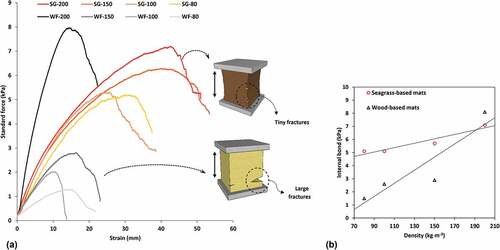
The microscopy images presented in show the cut cross-sectional side of the produced mats. The dissimilarities in terms of stretchability and high internal bond strength for the two types of mats are associated with the ability of the single Bico fibers (indicated by blue arrows) to bond with the raw material and, most importantly, to bond with each other. Seagrass leaves are larger aggregates compared to wood fibers, and, as a result, their corresponding mats have large voids and pores as reflected in density fluctuations (). The presence of large voids can facilitate the bonding (white arrows) of Bico fibers with each other (, white arrows), constructing a three-dimensional network of plastic fibers with seagrass leaves incorporated into their structure. In addition, some Bico fibers are also bonded with the seagrass leaves, resulting in an even more sturdy structure.
Figure 5. Digital micrographs and images obtained by scanning electron microscopy of seagrass-based (SG) mats (a, c), and wood-based fiber (WF) mats (b, d). Blue arrows indicate the Bico fibers, white arrows indicate the bond between two Bico fibers and red arrows indicates the bond between Bico and wood fiber.
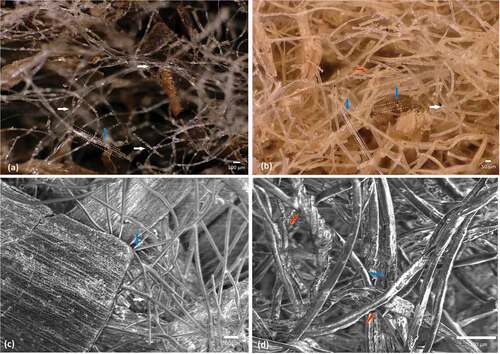
In the case of WF mats, Bico fibers tended to predominately bond to wood fibers rather than with other Bico fibers (, red arrows). As the proportion of binding fibers is only 10 wt%, and they are well dispersed in the mixture, it might be presumed that they are surrounded by wood fibers forming tiny wood fiber agglomerates (fibers interlocked with each other). The strength of the bond (degree of adhesion) between two plastic Bico fibers seemed to be higher than the Bico-wood fiber bond. During the hot-pressing process, the applied heat partially melts the outer layer of Bico fibers. Sintering acts to bond fibers together into a strong network. As for the Bico-wood fiber bond, the degree of sintering is lower. As a result, the wood fibers can de-bond easier when subjected to transversal stress, resulting in lower internal bond strength and stretchability (elasticity).
Similar studies have reported that the type of binder affects the strength of the insulation material (Imken, Kraft, and Mai Citation2021). Both compressive and internal bond strength of materials bonded with bico fibers appear to be lower than when other binders such as pMDI are used (Imken, Kraft, and Mai Citation2021). Higher strength values were obtained when using other natural fibers such as flax, jute, and hemp compared to our results (Korjenic, Zach, and Hroudová Citation2016). However, it should be noted that the proportion of bico fibers in the aforementioned study was twice as high as in our study, which might lead to strength increase.
Compared to the corresponding WF mats, the SG mats appear to be more flexible (). For both types of mats, flexibility tends to decrease with increasing density. The lower the density, the less compact the mats and the lower the resistance to deformation. Flexibility (the opposite of stiffness) was particularly high for the low-density mats, reaching up to 6.7 mm N−1.
The ability of the mat to return to its original shape (elasticity) was measured by determining the bending force during release of the load cell. As can be seen in , the bending resistance of the mat drops sharply after the strain reaches 20 mm and the load cell is released back, and then stabilizes when the strain is reduced to 0. At a strain of about 2 to 4 mm, the bending resistance force is 0, which means that the load cell is no longer in contact with the specimen. This behavior indicates that the after bending the mat can recover its initial position up to 90%. The low strain at which the bending resistance force becomes 0 N indicates a high ability of the mat to return to its original position (high elasticity). On the other hand, the leaf-like structure formed (hysteresis) indicates that the mats have partial plastic deformation. It should be noted that the larger the area within the leaf-like structure, the higher the plastic behavior of the mat. Conversely, the larger the area below the leaf-like structure, the more elastic the behavior. clearly shows that low density mats (SG-80 and WF-80) are more elastic than high density mats. An easily bendable mat, contrarily to stiff boards, can be used to insulate irregular areas in the building.
Thermal conductivity
shows the thermal conductivity for various densities. For target densities starting at 80 to 200 kg m−3, thermal conductivity initially decreased and then tended to increase. Its values varied from 0.0390 to 0.0510 W m−1 K−1 for SG mats and from 0.0389 to 0.0465 W m−1 K−1 for WF mats. It should also be noted that the real densities of SG mats have deviated from the target density and are considerably higher than WF mats. Therefore, thermal conductivities are expected to be significantly higher for the former. Still, SG mats exhibit similar or even lower thermal conductivities than boards prepared by other natural resources. Previous research has reported that the thermal conductivity of most mineral and lignocellulosic materials varies from 0.030 to 0.070 W m−1 K−1 (Hung Anh and Pásztory Citation2021; Kumar et al. Citation2020). Other natural non-conventional fibers used to produce flexible materials (nonwovens) have shown promising results in terms of thermal conductivity. Thilagavathi et al. (Citation2020), Samanta et al. (Citation2021) and Kumar et al. (Citation2021) reported very low thermal conductivity values of 0.02 to 0.05 m−1 K−1, which are comparable or even better than those of synthetic insulation materials. However, due the low density, it would be expected that the mechanical properties would also be low. In another study using Bico-bonded mats with lower or similar densities to ours, thermal conductivities vary between 0.04 and 0.05 m−1 K−1 (Korjenic, Zach, and Hroudová (Citation2016). From , it appears that materials based on seagrass leaves have similar thermal conductivities to the natural fibers (hemp, flax and jute) from the study mentioned above.
Figure 7. Thermal conductivity at 23 ºC (λ23) of seagrass-based (SG) and wood fiber-based (WF) mats at various densities.
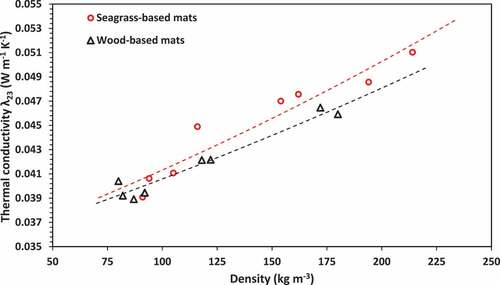
The predominant mechanisms of heat transfer in the case of indoor insulation materials are convection and conduction. Convection is the movement of heat by the actual motion of air molecules through the air voids of the mats. Conversely, conduction can occur through the raw lignocellulosic aggregates and the Bico fibers. The slightly higher thermal conductivity of SG mats compared to WF mats is mainly associated with the thermal conductivity of seagrass leaves and their arrangement in the mat (presence of large voids). Materials with the same density but larger pore sizes can transfer heat better via convection because the air can flow more easily (Hung Anh and Pásztory Citation2021; Xie et al. Citation2011). Another reason for the high thermal conductivity of SG compared to WF mats could be related to the ability of bico fibers to bond and transfer heat to each other. Since Bico fibers are plastic materials, they have higher thermal conductivity than lignocellulosic materials (Ebadi-Dehaghani and Nazempour Citation2012). In the case of SG mats, the Bico fibers tend to predominantly interconnect and form a three-dimensional network. Heat is thus transferred (conduction) through the net-like structure, resulting in higher thermal conductivity of SG compared to WF mats.
Fire resistance
Insulation boards made of natural or synthetic organic materials have been shown to be problematic when it comes to resistance to fire (Graupner and Müssig Citation2010; Kumar et al. Citation2020; Zou et al. Citation2021). Seagrass leaves may contain high amounts of minerals (sand, salts) as they are collected from the seashores. Previous studies have confirmed that composites containing seagrass fibers (species: Posidonia oceanica) do not burn quickly and are nonflammable (Mayer et al. Citation2022). Cone calorimetry data are presented in and . Results showed that SG mats displayed higher fire resistance than WF mats. All of the specimens ignited within the first 10 seconds. Initially, a major heat peak was noticed for both types of mats. However, the peak intensity was significantly different for the two types. The peak heat release (PHR) was not dependent on the density of the mats. WF mats had a PHR value approximately twice as high as SG mats (). The total heat release (THR), which represents the total amount of energy released during the test period (1800 s), was again considerably higher for the WF mats compared to SG mats. The THR values depended on the density of WF mats. With increasing density, the mass of organic material per unit volume increased, leading to the increment of the energy released during combustion. The THR for seagrass-based mats, on the other hand, did not seem to be affected by density but rather by the duration of flaming. For all SG mat specimens, the flame intensity was very low. Only tiny flames appeared during the combustion process. Nevertheless, the flame period observed for SG-80 and SG-200 was much longer than for SG-100 and SG-150. The mass-loss rate (MLR) at 300 s varied from 0.051 to 0.055 g s−1 for SG mats and 0.056 to 0.098 g s−1 for WF mats. It is evident that the former burn and degrade more slowly compared to the latter.
Table 3. Results of cone calorimetry tests.
The predominant parameters affecting the combustion of raw materials might be their chemical composition and morphological characteristics. A subsequent thermogravimetric analysis (TGA) was conducted to better understand the effect of these parameters. The TGA can reveal the impact of the chemical composition of the lignocellulosic material on the combustion process of the insulation mats.
The TGA curves () showed that after moisture release, thermal degradation of seagrass and wood fibers went through two different processes: the devolatilization step occurred between 250 and 350°C, and char formation took place above 350°C. The release of volatiles is attributed to the decomposition of three main constituents (hemicelluloses, cellulose and lignin), while the last step is assigned only to the combustion of previously formed char residues (Rowell Citation2005). There are two possible mechanisms associated with the higher fire resistance of seagrass compared to wood fibers. Firstly, due to the chemical composition of seagrass, the chemicals released in the first stages of oxidation alter fuel production by increasing the amount of char and reducing the amount of volatile combustible vapors and lowering the temperature at which pyrolysis begins. The pyrolysis/oxidation reactions are altered so that the thermal composition occurs at lower temperatures than wood fibers. As a result of this alteration, the amount of levoglucosan is reduced, leading to a reduction in the amount of volatile, combustible gases. This is similar behavior to fire-retardant-treated materials (LeVan and Winandy Citation1990; Rowell Citation2005). Secondly, another possible mechanism for the fire-retardancy of seagrass might be associated with salts such as sodium chloride (NaCl) on its surface. The presence of the salts might affect the vapor-phase reactions, as they may inhibit the chain reactions that involve the recombination of oxygen ions with halides (Cl-). The residual mass of burned seagrass is significantly higher compared to that of wood fibers (approximately 14%). It indicates the presence of high ash content in seagrass (sand particles, salts and other minerals).
The mass lost during the flame period in the cone calorimeter was considerably low for seagrass-based mats. This value can be as low as 24% of the total weight of the specimen (). The chemical composition of seagrass plays a determining role in the fire resistance of the respective SG mats. Regarding the Bico fibers, the TGA shows two major deviations of the TG curve. In the first period, from ⁓270 to 360ºC, PE apparently oxidizes, implying a reduction in mass, while oxidation of PP occurs at higher temperatures (⁓360 to 480ºC). The plastic Bico fibers are entirely oxidized at 600 ºC.
Conclusion
Wood-based insulation boards have been already known as an ecological alternative to synthetic materials because of their ability to sequester carbon. Still, considering the scarce availability of wood and the high energy input for the production of wood fibers (refining process), other resources should also be taken into consideration. The seagrass leaves could be a potential candidate for fabricating insulation materials. The Mats composed of seagrass exhibit lower compression strength but higher internal bond than the reference WF mats. In terms of flexibility, SG mats are very elastic, especially at low target densities, as the binding fibers adhere to one another to form a stable three-dimensional network. The thermal conductivity of SG mats varies from 0.039 to 0.051 W m−1 K−1 and is correlated with the mats’ density. Mats comprised of seagrass have slightly higher thermal conductivity compared to those of wood, which is comparable to other known natural fibers. Regarding fire resistance, the low heat release rate of SG mats shows that seagrass leaves are an adequate and cost-effective resource for increasing the fire safety of buildings as no fire retardant needs to be applied. The difficulty in the combustion of SG mats is attributed to the chemical composition of seagrass leaves. The produced mats are adequate for interior wall partitions and roofing applications and are easy to install as they are flexible. The insulation products made from abundant waste material such as seagrass Zostera marina can be a sustainable and cost-effective solution for the building sector.
Highlights
The thermal conductivity of produced mats varied from 0.039 to 0.051 W m−1 K−1.
Seagrass-based mats possess exceptional fire resistance.
Seagrass-based mats exhibit higher internal bond compared to wood fiber-based mats.
Low-density mats are more flexible compared to those having high density.
Flexible seagrass-based mats can used for building insulation, particularly in irregular areas around the building.
Acknowledgments
The authors acknowledge support by the Open Access Publication Funds of the Göttingen University. This work was also supported by DAAD (German Academic Exchange Service). Funding was provided through the funding programme: Research Grants - Doctoral Programmes in Germany, DAAD.
Disclosure statement
No potential conflict of interest was reported by the author(s).
References
- Ayadi, M., R. Zouari, C. Segovia, A. Baffoun, S. Msahli, and N. Brosse. 2022. Development of airlaid non-woven panels for building’s thermal insulation. Construction Technologies and Architecture 1:772–15. www.scientific.net/CTA.1.772.
- Benthien, J. T., and M. Ohlmeyer. 2017. Influence of face-to-core layer ratio and core layer resin content on the properties of density-decreased particleboards. European Journal of Wood and Wood Products 75 (1):55–62. doi:10.1007/s00107-016-1059-5.
- DIN EN 12667. 2001. Thermal performance of building materials and products - determination of thermal resistance by means of guarded hot plate and heat flow meter methods - products of high and medium thermal resistance;. In German version EN, Vol. 12667, 2001. Berlin, Germany.
- DIN EN 1607. 2013. Thermal insulating products for building applications - determination of tensile strength perpendicular to faces. In German version EN 1607:2013. Berlin, Germany.
- DIN EN 826. 2013. Thermal insulating products for building applications - determination of compression behaviour. In German version EN, Vol. 826, 2013. Berlin, Germany.
- Ebadi-Dehaghani, H., and M. Nazempour. 2012. Thermal conductivity of nanoparticles filled polymers. London, UK: INTECH Open Access Publisher.
- Graupner, N., and J Müssig. 2010. Technical applications of natural fibres: An overview Müssig, J. In Industrial applications of natural fibres: Structure, properties and technical applications. West Sussex, UK: John Wiley & Sons, Ltd 73–86.
- Hamdaoui, O., L. Ibos, A. Mazioud, M. Safi, and O. Limam. 2018. Thermophysical characterization of posidonia oceanica marine fibers intended to be used as an insulation material in mediterranean buildings. Construction and Building Materials 180:68–76. doi:10.1016/j.conbuildmat.2018.05.195.
- Hung Anh, L. D., and Z. Pásztory. 2021. An overview of factors influencing thermal conductivity of building insulation materials. Journal of Building Engineering 44:102604. doi:10.1016/j.jobe.2021.102604.
- Imken, A. A., R. Kraft, and C. Mai. 2021. Production and characterisation of wood-fibre insulation boards (WFIB) from hardwood fibres and fibre blends. Wood Material Science & Engineering 1–7. doi:10.1080/17480272.2021.1958919.
- ISO 5560-1. 2002. Reaction-to-fire tests - heat release, smoke reduction and mass loss rate - part 1 - heat release rate (cone calorimeter method), 5660–1. Geneva, Switzerland.
- Jedidi, M., and A. Abroug. 2020. ”Valorization of Posidonia oceanica Balls for the Manufacture of an Insulating and Ecological Material.” Jordan Journal of Civil Engineering 14.3.
- Korjenic, A., J. Zach, and J. Hroudová. 2016. The use of insulating materials based on natural fibers in combination with plant facades in building constructions. Energy and Buildings 116:45–58. doi:10.1016/j.enbuild.2015.12.037.
- Kumar, D., M. Alam, P. X. Zou, J. G. Sanjayan, and R. A. Memon. 2020. Comparative analysis of building insulation material properties and performance. Renewable and Sustainable Energy Reviews 131:110038. doi:10.1016/j.rser.2020.110038.
- Kumar, N. M., T. G, P. S, and V. V. 2021. Development of needle punched nonwovens from natural fiber waste for thermal insulation application. Journal of Natural Fibers 19 (14):1–9. doi:10.1080/15440478.2021.1990175.
- Kuqo, A., A. Korpa, and N. Dhamo. 2019. Posidonia oceanica leaves for processing of PMDI composite boards. Journal of Composite Materials 53 (12):1697–703. doi:10.1177/0021998318808024.
- Kuqo, A., and C. Mai. 2022. Seagrass leaves: An alternative resource for the production of insulation materials. Materials 15 (19):6933. doi:https://doi.org/10.3390/ma15196933.
- LeVan, S. L., and J. E. Winandy. 1990. Effects of fire retardant treatments on wood strength: A review. Wood and Fiber Science 22:113–31.
- Mayer, A. K., A. Kuqo, T. Koddenberg, and C. Mai. 2022. Seagrass-and wood-based cement boards: A comparative study in terms of physico-mechanical and structural properties. Composites Part A, Applied Science and Manufacturing 156:106864. doi:10.1016/j.compositesa.2022.106864.
- Mehrez, I., H. Hachem, R. Gheith, and A. Jemni. 2022. Valorization of Posidonia-Oceanica leaves for the building insulation sector. Journal of Composite Materials. 56:1973–1985. doi:10.1177/2F00219983221087793
- Rowell, R. M. 2005. Handbook of wood chemistry and wood composites. London, UK: CRC press.
- Samanta, K. K., I. Mustafa, S. Debnath, E. Das, G. Basu, and S. K. Ghosh. 2021. Study of thermal insulation performance of layered jute nonwoven: A sustainable material. Journal of Natural Fibers 19 (11):1–14. doi:10.1080/15440478.2020.1856274.
- Schulte, M., I. Lewandowski, R. Pude, and M. Wagner. 2021. Comparative life cycle assessment of bio‐based insulation materials: Environmental and economic performances. GCB Bioenergy 13 (6):979–98. doi:10.1111/gcbb.12825.
- Shi, J. L., S. Y. Zhang, B. Riedl, and G. Brunette. 2005. Flexural properties, internal bond strength, and dimensional stability of medium density fiberboard panels made from hybrid poplar clones. Wood and Fiber Science 37:629–37.
- Teppand, T. G., D. Jones and C. Brischke. 2017. Performance of bio-based building materials. Duxford, UK: Woodhead Publishing.
- Thilagavathi, G., N. Muthukumar, S. Neela Krishnanan, and T. Senthilram. 2020. Development and characterization of pineapple fibre nonwovens for thermal and sound insulation applications. Journal of Natural Fibers 17 (10):1391–400. doi:10.1080/15440478.2019.1569575.
- Tsemekidi-Tzeiranaki, S., N. Labanca, B. Cuniberti, A. Toleikyte, P. Zangheri, and P. Bertoldi. 2019. Analysis of the annual reports 2018 under the energy efficiency directive—summary report. Publications Office of the European Union: Luxembourg.
- Wang, S., P. M. Winistorfer, T. M. Young, and C. Helton. 2001. Step-closing pressing of medium density fiberboard;part 1. Influences on the vertical density profile. Holz als roh-und Werkstoff 59 (1–2):19–26. doi:10.1007/s001070050466.
- Wyllie-Echeverria, S., and P. Alan Cox. 1999. l’industrie de l’ailleul (zostera marina zosteraceae) de la nouvelle-Écosse (1907–1960). Economic Botany 53 (4):419–26. doi:10.1007/BF02866721.
- Xie, Y., Q. Tong, Y. Chen, J. Liu, and M. Lin. 2011. Manufacture and properties of ultra-low density fibreboard from wood fibre. BioResources 6:4055–66.
- Zannen, S., M. T. Halimi, M. B. Hassen, E. H. Abualsauod, and A. M. Othman. 2022. Development of a multifunctional wet laid nonwoven from marine waste posidonia oceanica technical fiber and CMC binder. Polymers 14 (5):865. doi:10.3390/polym14050865.
- Zou, S., H. Li, L. Liu, S. Wang, X. Zhang, and G. Zhang. 2021. Experimental study on fire resistance improvement of wheat straw composite insulation materials for buildings. Journal of Building Engineering 43:103172. doi:10.1016/j.jobe.2021.103172.

